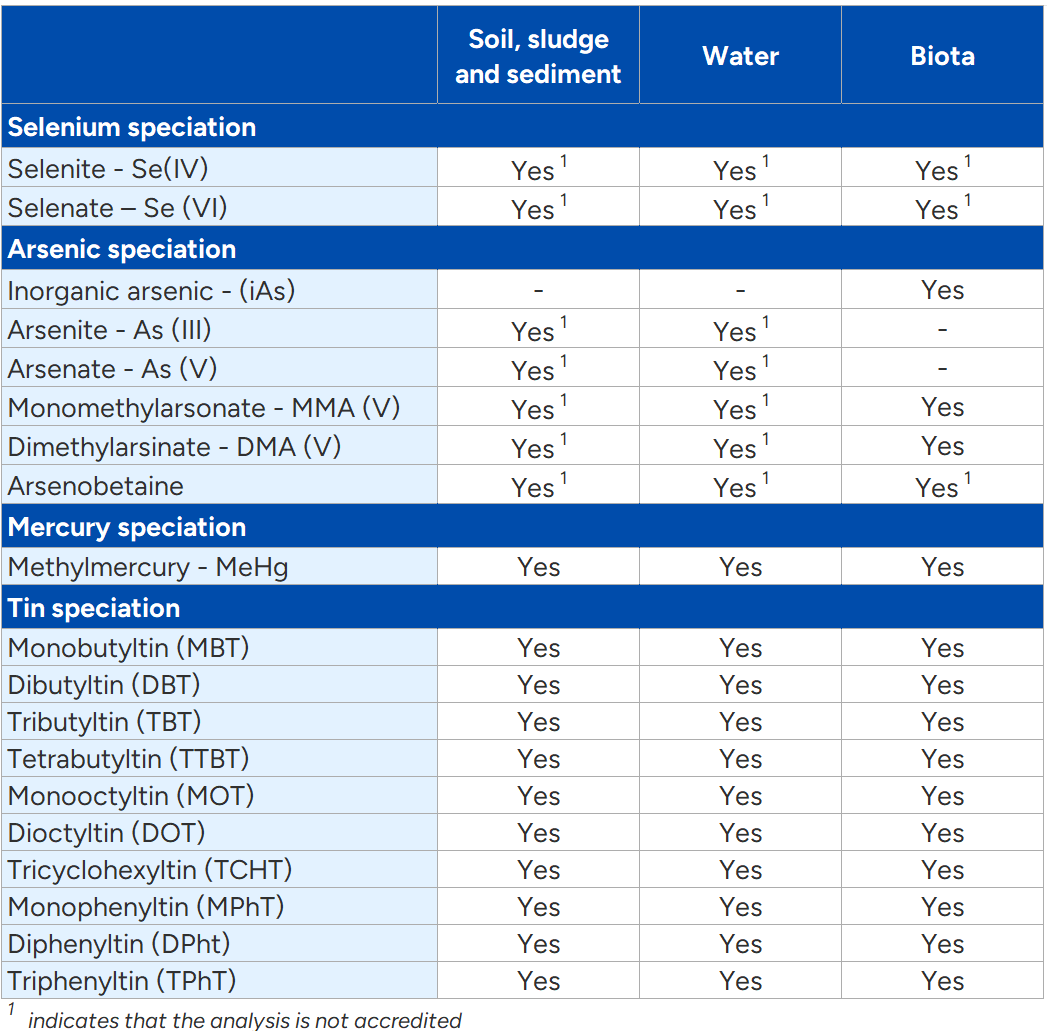ALS Scandinavia offer a wide range of metal speciation analyses by LC-HG-ICPMS and GC-ICP-MS. Our laboratory has more than a decade of experience in metal speciation testing and is specialized in measuring the most toxic arsenic (As), mercury (Hg), selenium (Se) and organotin (OTC) compounds. ALS Scandinavia offers accredited metal speciation analyses of:
- Soil, sediment and sludge
- Water
- Biota
- Food and feed
- Blood, urine and serum
Testing capabilities
- Inorganic and organic arsenic - Arsenite, arsenate, dimethylarsinate & monomethylarsonate
- Methylmercury
- Selenite & selenate
- Organotin compounds - MBT, DBT, TBT, TTBT, MOT, DOT, TCHT, MPhT, DPhT & TPhT
By combining our cutting-edge technology, experience and in-house research, ALS can offer you the latest in the field of metals speciation. Please read more about our metal metal speciation analyses or contact us for more information.
Metal speciation as part of environmental monitoring and risk assessment
The toxicity, bioavailability and mobility of an element can be highly dependent on the form in which it is present. Selenium, for example, is an essential micronutrient that is naturally occurring in our ecosystems. However, even moderate increases – particularly from industrial or mining activities, can lead to ecological harm. Some forms are bio accumulative meaning concentrations rise by each step in the food chain. Bioaccumulation explains how some animals may have higher concentrations of an element compared to the surrounding environment.
Consequently, speciation analysis can provide valuable additional information and insight compared to a traditional measurement of the total elemental concentration. Over the last few years, new legislation and guidelines have been published that introduce threshold values for organotin compounds, inorganic arsenic and methylmercury.

Metal speciation vs. total concentrations
Selenium speciation
While elemental selenium and selenides generally have a low bioavailability, the inorganic selenium compounds selenite and selenite are toxic. In the field of ecotoxicology, selenium is a particularly interesting element since there is a relatively fine line between essential and toxic selenium concentrations. Read more here.
Arsenic speciation
Arsenic occurs in organic and inorganic forms. Organic arsenic, the predominant form present in seafood, is not particularly harmful. Inorganic arsenic however is toxic and long-term exposure may cause skin lesions or cancer. Read more here.
Methylmercury
Methylmercury is highly toxic and is formed from inorganic mercury through the process of methylation. This occurs for example in the sea as well as in lakes and rivers, soils and sediments. Methylmercury is biomagnified in aquatic food chains meaning the concentration increases for each step in the food chain. Read more here.
Organotin compounds
The element tin (Sn) is not considered particularly harmful, but some organotin compounds are toxic and is a threat to humans, plants and animals. Organotin compounds have been used as biocides in boat paint, wood impregnation and as preservatives and pesticides. Read more here.